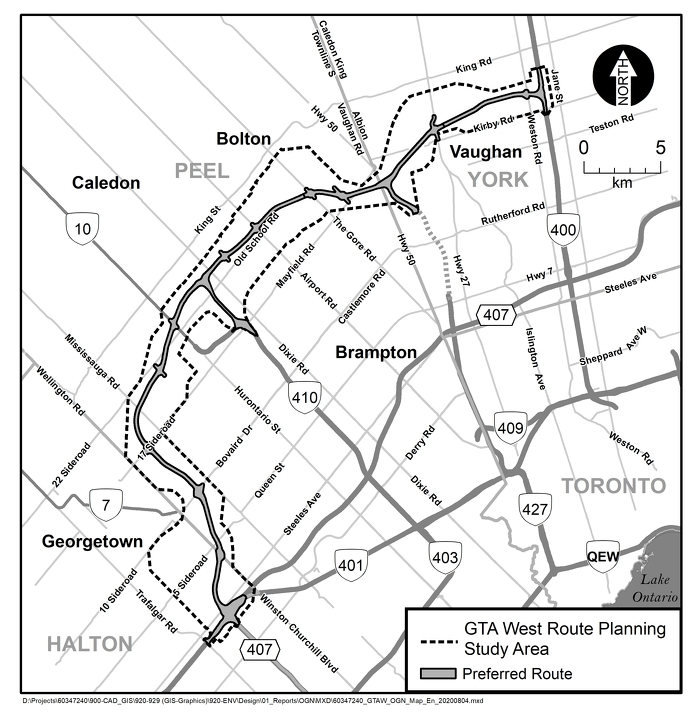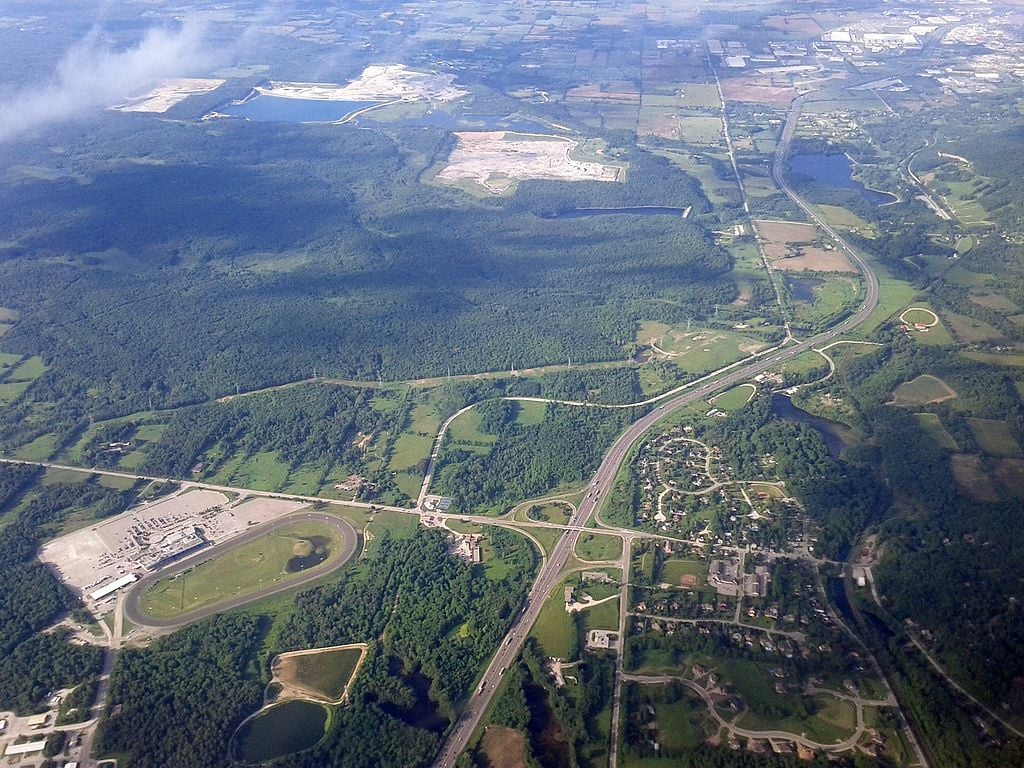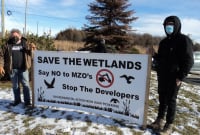Support strong Canadian climate journalism for 2025
Ontario’s Peel Region pulled its support for the Ford government’s plan to build a highway through the Greenbelt on Thursday, joining a flurry of councils turning their backs on the project.
The Ford government is proposing to fast-track an environmental assessment for the proposed GTA West corridor — also known as Highway 413 — which would connect suburbs north and west of Toronto. But with public opposition to the project heating up, nearly every municipality along its route has either yanked support or joined calls for the federal government to step in.
“It just seems like now there's a little bit of pressure, dominoes are falling one by one,” said Sarah Buchanan, the clean economy program manager at the non-profit Environmental Defence, which sent an official request for Ottawa to intervene.
The 59-kilometre proposed highway is an old idea, dropped by the previous Liberal government after a study found it would save commuters less than a minute while increasing carbon emissions. The Ford government revived the $6-billion proposal in 2018, saying it could relieve congestion issues in the fast-growing Toronto suburbs and boost Ontario’s economic recovery from COVID-19.
“Without strong action, the projected population growth in the (Greater Toronto Area) will overwhelm our existing infrastructure and make life more expensive for working families,” Natasha Tremblay, a spokesperson for Transportation Minister Caroline Mulroney, said in a statement.
“We need our roads infrastructure to keep up.”
However, research suggests building new roads tends to attract more drivers and doesn’t improve congestion.
The highway would also have a significant impact on the environment, running through the Greenbelt and prime agricultural land. It would disrupt 85 waterways, 220 wetlands, 10 different species-at-risk and hundreds of acres of vulnerable wildlife habitat, the Toronto and Region Conservation Authority has said. (Provincial transportation projects are exempt from getting approval from conservation authorities, but the agency is giving scientific advice to the province.)
The province is allowed to build new transportation infrastructure through the Greenbelt, but citizens and environmentalists have said they’d rather see more transit options in their communities.
“We have some politicians and elected officials that seem to think it's a good idea to pave over our Greenbelt and our farmland so people can get their Amazon packages within two days of ordering them,” said Irene Ford, a Vaughan resident who has helped organize against the project as part of a group called Stop the 413.
“I'm not really supportive of that … I just think this highway symbolizes so much about what people envision for the future of Ontario and for the future of their communities.”
For a long time, Highway 413 was backed by local municipalities. But in the past few weeks, under sustained pressure, municipal officials started to reconsider.
Then the Ford government started to water down its rhetoric, saying more consultation was needed.
“If it makes sense to build this piece of infrastructure, we will. If it doesn’t, we won’t,” government house leader Paul Calandra said last week amid questions from opposition MPPs.
Mulroney's office echoed that perspective: “We want to get this right, and we are fully committed to continued consultation … Work on the GTA West corridor continues and will ultimately determine if this is a viable project for York, Peel and Halton regions,” Tremblay said in a statement.
In the meantime, prominent local conservatives have also weighed in against the project. Wellington-Halton Hills MP Michael Chong, a federal Conservative, argued the highway "should not be built" in an opinion piece last month.
“Up until six months ago, this was a done deal,” said Jenni Le Forestier, a Caledon resident who has pressed her local council on the issue.
“There’s been a very big shift in the conversation.”

After Peel Region’s vote Thursday, it joins the municipalities of Mississauga, Vaughan, Halton Hills, Halton Region and Orangeville in opposing the project. Though the corridor wouldn’t directly impact Toronto, that city’s council also passed a resolution condemning it this week. Two other municipalities, Brampton and Caledon, have backed away from supporting the streamlined environmental assessment, but haven’t turned their backs on the highway entirely.
The only municipalities that haven’t changed their stances on Highway 413 are King Township and York Region. Both are holding meetings on the issue later this month.
“King is proud of our environmental stewardship and will be considering this important issue again,” King Township Mayor Steve Pellegrini told Canada's National Observer in an email last week.
In May, federal Environment Minister Jonathan Wilkinson is expected to decide whether Ottawa will take over the project’s environmental assessment.
The Impact Assessment Agency had received 124 comments from the public about Highway 413 as of Thursday night, nearly all of them negative.
The Ford government is also mulling plans for a second controversial highway called the Bradford Bypass, which would run for 16.2 kilometres through a northern section of the Greater Toronto Area. Environmental groups have also asked Ottawa to intervene on that project, which would cut through the Holland Marsh, an ecologically sensitive area of wetland that also contains some of the richest farmland in Ontario.





Comments
Pleass check your facts. The proposed 413 corridor runs just south in parallel to the Greenbelt, not through it. The Globe and Mail showed a map detailing where 413 would go in relation to the Greenbelt a few weeks ago. Additionally, after a quick google search, the proposed Bradford Bypass would not pass through the Holland Marsh either.
Hi Colin, thanks for weighing in. This article was fact-checked and your assertions are not accurate. I'll provide some more information below, and hopefully that helps clear things up!
I'm not sure about the Globe article you reference, but in recent weeks that publication has also noted that Highway 413 would run through the Greenbelt. You can see this yourself on maps published by the province. Though the bulk of the lands included in the Greenbelt are indeed located to the north of the proposed route, there are slices that extend further to the south and would intersect with the highway:
https://www.gta-west.com/wp-content/uploads/2018/11/Preliminary-Route-P…
Also, I am not sure where you're getting your information about the Bradford Bypass, but current maps of its proposed path show that it will go through the Holland Marsh. The municipality of Bradford West Gwillimbury says so here, for example:
https://www.townofbwg.com/400-404-connecting-link
You can come to the same conclusion by comparing a map of the Greenbelt/Holland Marsh to the province's map of the Bradford Bypass.
Greenbelt map: https://www.greenbelt.ca/maps
Bradford Bypass map:
https://www.bradfordbypass.ca/overview/
Pleass check your facts. The proposed 413 corridor runs just south in parallel to the Greenbelt, not through it. The Globe and Mail showed a map detailing where 413 would go in relation to the Greenbelt a few weeks ago. Additionally, after a quick google search, the proposed Bradford Bypass would not pass through the Holland Marsh either.
Hi Colin, these assertions are not accurate. I've addressed your concerns below your other comment.
The map shows 413 stopping at the 400. - in other words dumping its load of traffic to add to the existing carnage on the 400. Have the municipalities north of this been consulted? What happens to the 413 traffic heading south does it get siphoned off at the 407 or go on to the 401?. I don't really see how the 413 will accomplish anything except to spread the pollution from the vehicles on the existing highways further north to sully the greenbelt environment.